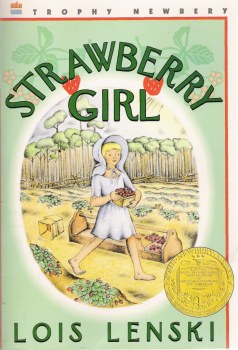 I’ve been running out of my own books to read, but my last foray through the shelves brought me face to face with Lois Lenski’s Strawberry Girl, a book I had bought for my daughter because it was one of my childhood favorites. As I pulled it off the shelf and removed the crisp dust jacket, it was clear my daughter had never read it.
I’ve been running out of my own books to read, but my last foray through the shelves brought me face to face with Lois Lenski’s Strawberry Girl, a book I had bought for my daughter because it was one of my childhood favorites. As I pulled it off the shelf and removed the crisp dust jacket, it was clear my daughter had never read it.
What was it, I wondered, about this book that I had liked so much? I admitted to myself that I really didn’t remember the book at all. It had been waiting on that shelf for someone to read it for at least 15 years, so I decided it was time to rediscover it.
To be honest, I do not remember how old I was when I first read Strawberry Girl. The story is illustrated with Lenski’s own pencil drawn images that evoke the hard scrabble life of its characters. However, it’s no book for a young child, with 15 chapters and 194 pages. This would have been the kind of book I was reading in third or fourth grade.
Strawberry Girl is one in a collection of regional fiction for children that Lenski wrote. First published in 1945, it takes place in Galloway, Florida, southwest of Orlando, near Lakeland where the author lived for a time. The young protagonist, Birdie Boyer, is a ten-year-old girl whose family moves from Marion County to Galloway to grow strawberries, sweet potatoes, and oranges to sell. Her father would rather be a farmer than manage herds of animals. The main conflict the family has is with their new neighbors, the Slaters, a poor, illiterate family that has been squatting on their land for generations and who has no notion that they should feed their livestock; instead they let them roam freely to forage, even if that means the animals are trampling their neighbor’s crops. While the Boyer’s are not wealthy by any means, they believe in sending their children to school and in modern conveniences, like an ice box. The Slaters, in comparison, live quite literally from hand to mouth.
Emily Dickinson said that books are frigates that take us lands away, and certainly this book took me on an interesting journey. In addition to witnessing the battles the Boyer’s have with their neighbors, readers get an excellent sense of rural life, from planting and nurturing strawberries to cutting and grinding sugar cane. The book is also filled with critters, from the family’s stubborn mule, to runaway pigs, to snakes, raccoons, and of course, alligators.
Lenski captured the rural Florida dialect of the time, and I wonder what I thought about that when I first read this book as a child. Was it something I enjoyed? To this day, I am a person who is interested in the way people from different regions talk. Did that begin years ago with this book. It’s hard to say, but maybe.
The landscape is rich, diverse, and not at all Midwestern, which certainly makes it exotic. I had never been to Florida when I was younger, but have gone there during spring break for the past seven or so years. We’ve even journeyed inland, away from the coast, to see the places Birdie Boyer roamed. Spanish moss is everywhere, like carelessly tossed tinsel on a Christmas tree. One time we even saw a razorback crossing the road. But it is not necessary for one to have been there in person; Lenski’s setting is vivid enough to imagine it all.
Florida in the steamy summer, with all its varied insects and animals, is not a place I’d go barefoot as I did constantly as a Midwestern child, but Birdie Boyer does. She’s a tough little girl with a mind of her own and a generous, forgiving heart that speaks well of her upbringing. I like her and I imagine I thought she was pretty amazing when I first met her.
I know that we are far removed from the 1940’s, but the characters and the life lessons this book presents are as relevant today as ever. I would certainly recommend Strawberry Girl to readers of all ages, for it is, I have rediscovered after all these years, still one of my favorites.
